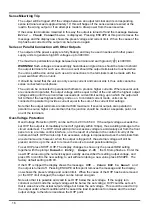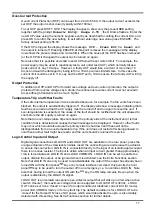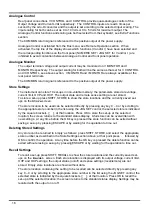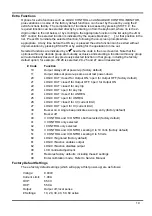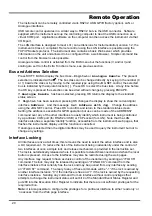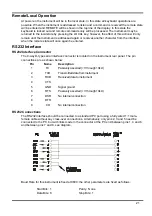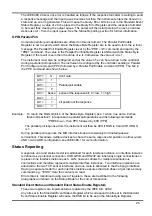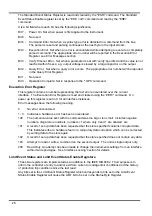
Initial Operation
This section of the manual is a general introduction to the controls and operation of the
instrument and is intended to be read before using the power supply for the first time.
In this manual front panel keys, connections and indicators are shown in capitals, e.g. ESCAPE,
JOG SET, OUTPUT, ON. Messages shown on the display are printed in a different type-font, e.g.
Enter V
,
Limits
,
CV
,
Store
.
Switching On, Output On/Off
The power switch is located at the bottom left of the front panel.
At power-up the default behaviour is for the instrument's settings to be restored to those
automatically saved when it was switched off, but with the Output always off (
OUTPUT OFF
is
shown in the display). However, the user can change this default setting such that the Output is
also restored at power-up to its status at power-down, see the Extra Functions section.
The DC Output is switched on and off electronically with alternate presses of the
key; the
ON lamp illuminates when the Output is on. At the same time the message above the VOLTS and
AMPS display changes from
OUTPUT OFF
to
CV
(constant voltage) or
CI
(constant current) to
indicate the present operating mode; should the load cause the instrument to operate outside its
guaranteed power range the display will instead show
UNREG
(unregulated).
Keypad
Only the principles of operation are outlined here; the setting of individual parameters is given in
detail in later sections.
The paramount consideration in designing the user interface has been to make changing settings
as 'safe' as possible (i.e. with minimal risk of accidentally applying excessive voltages to a target
system) whilst achieving ease of use. This has been achieved by requiring the user to confirm
(OK) new numeric settings, with the option to ESCAPE at any point or even to simply pause until
the operation times-out and the instrument returns to its original settings. In addition, display
messages and LED indicators prompt, guide or warn the user such that entry or control errors are
minimised. Where some of these features (e.g. beeps) are considered unnecessary by regular
users, the option exists to disable them, see the Extra Functions section.
Under normal conditions the numeric keypad is disabled; pressing any key will cause the buzzer
to beep, indicating an illegal operation. To set a voltage with the keypad first press the V
NUMERIC SET key; the VOLTS display changes to show the present set value in a smaller font,
with the message
Enter V or ESC
below it, and the OK lamp starts flashing. The new value
is then entered from the keyboard; as it is entered it is displayed directly below the present
setting, replacing the prompt message. At any time during entry the new setting can be
confirmed with the OK key, e.g. it is sufficient to key in 1, OK to change the setting to 1Volt.
When OK is pressed the display reverts to show just the new setting in the full-size font and the
OK lamp stops flashing; if OK is not pressed within 10 seconds of the last numeric key the entry
is cancelled and the display returns to its original setting. If ESCAPE is pressed anytime in the
entry procedure, entry is cancelled and the display returns to its original setting. The current limit
is set in exactly the same way after first pressing I NUMERIC SET.
The OK key is used to confirm most keypad entries. At all other times it becomes the VIEW V/I
LIMITS key and pressing it will cause the display to show preset output voltage and current limit
for 3 seconds; during this period the
Limits
message shows in the display.
Pressing SHIFT illuminates the
▲
lamp and gives the numeric keys the functions marked above
them, e.g. STR (Store), RCL (Recall), etc. When a shift function is selected SHIFT is cancelled
(the
▲
lamp is no longer lit). The further key presses required to complete the selected function
are described in detail in the sections that follow; if no key is pressed within 10 seconds to
complete the function, the function will terminate as if ESCAPE has been pressed. SHIFT is a
toggle key; pressing SHIFT again when it has been selected will cancel SHIFT. SHIFT is also
cancelled by ESCAPE, or by pressing SET V or SET I.
11

















